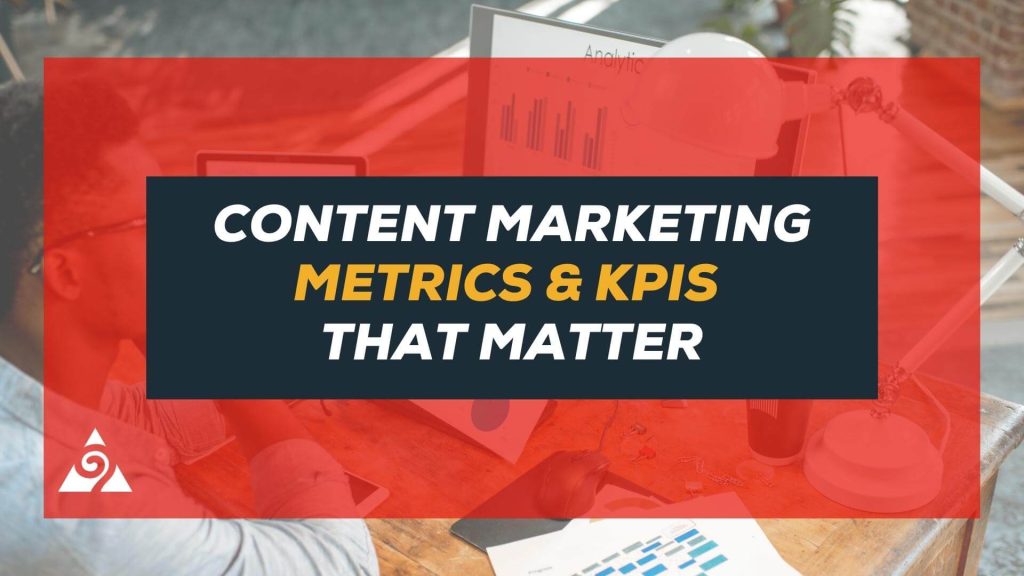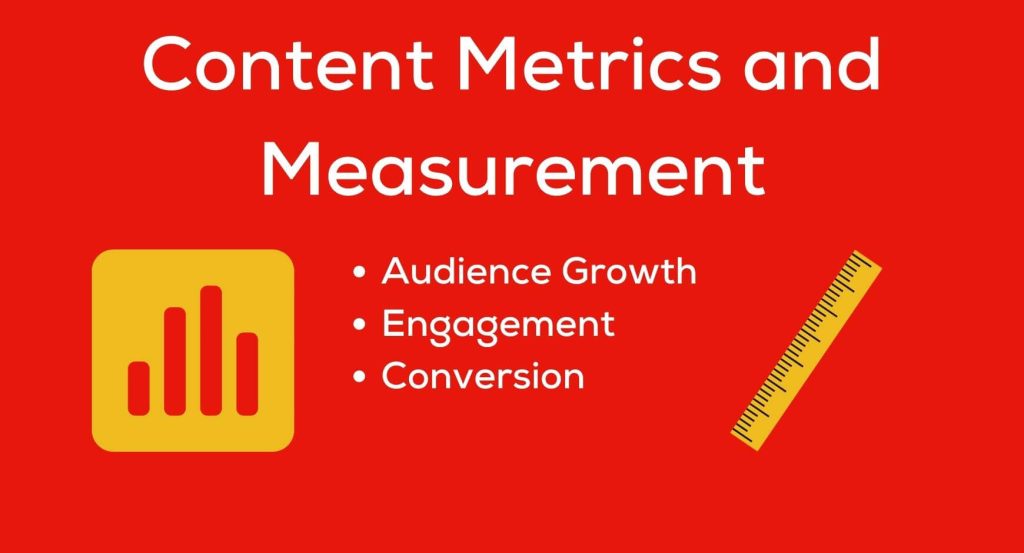Content marketing metrics can be a game-changer for any marketing campaign. If you are looking to level up your SEO strategy, using metrics can help maximize your return of investment (ROI) and business growth through intentional, relevant content.
The majority of businesses have embraced the effectiveness of SEO content marketing to increase traffic to their websites and establish them as trustworthy sources of information. However, many content marketing strategies fail to utilize content marketing metrics that matter in a meaningful way. Identifying your priority goals and creating a plan for how you will use metrics to measure progress towards those goals are key steps to a stellar content marketing strategy.
Skip to a section:
What Are Content Metrics?
Whether you are just starting to create SEO content or looking to revamp an old blog, content metrics can increase your marketing ROI. Content management metrics evaluate existing content which can also guide you in deciding which new content to create. But before you learn how to measure content marketing, you need to set specific business goals which will inform what data you collect, how you collect it, and how you analyze it.
- Metric: A metric is a measurable value that shows the performance of part of a company’s marketing campaign over a specific amount of time.
- KPI: A key performance indicator (KPI) is a measurable value that shows a company’s performance in achieving a specific business goal over a specific amount of time.
Content marketing isn’t the only place you should be leaning heavily on metrics. Using the right metrics for each part of your digital marketing campaign can ensure that you get the best ROI possible.
Goal Setting and Content Performance Analysis
Metrics should be used at all steps of the content marketing process. It all starts with choosing the right business goals. This should be done before you even start thinking about what content to create. Publishing content without goals is a waste of time.
It’s likely that content will be shallow and accomplish nothing for your brand, Google search engine page ranking, or organic traffic growth. Goal setting doesn’t have to be complicated. In fact, goals are often as simple as:
- Grow your audience
- Drive engagement
- Increase conversions
Content Marketing Metrics That Matter
Launching an effective content marketing campaign is all about direction. Once you have established your priority goals, you can have a clear direction in mind when you measure content performance.
In the case of metrics, aim for quality over quantity. Don’t use all 20 metrics that we will cover in this post. Instead, choose the ones that will most clearly tell you if you are on track to reach your content marketing goals and KPIs. To help you keep them all straight, we sorted the 20 most important content marketing measurements into three categories:
- Audience Growth Metrics
- Engagement Metrics
- Conversion Metrics
Audience Growth Metrics
Of all the content marketing performance metrics, audience growth metrics may be the most impactful for new businesses and businesses looking to grow. They tell you how many potential customers you are reaching through search engine results pages (SERPs), how many people return to your website more than once, and other essential information to guide content creation.
Content metrics to reveal who your audience is:
- Users: The number of site visitors, or users, tells you how much traffic your website is getting. Before you can get too wrapped up in audience growth, you need to know that people are visiting your site.
- Pageviews: This measure of content marketing shows how many times users visit a specific page on your site. It can tell you which pages perform better than others so you know where your content needs work and where it’s already working well.
- Sessions: A session is a period of time a specific user spends on your entire website. The session lasts until the user leaves the site or after about 30 minutes of inactivity.
Content Strategy: KPIs for Audience Growth
- New and Returning Users: Differentiating between new and returning users is essential to any content marketing measurement framework. An increased number of returning users shows that you’re growing your audience.
- Sessions per User: This KPI describes the average number of sessions per user. More sessions per user means more returning users. This shows that you are effectively moving potential customers down the buyer’s journey which can lead to a higher number of conversions later on.
- SERP Rank: SERP rank is one of the most important KPIs for content strategy. SERP rank is the position your page is at on a search engine results page. A higher SERP rank is ideal because more users will see your page. Relevant keywords, a quality landing page, and great pillar content are some of the best ways to increase your rank.
- Click-Through Rate: In SEO, click-through rate (CTR) shows how many users click on your page when it appears in the SERPs. A high CTR means you are effectively ranking for the right keywords to reach your desired audience.
Learn more about how to increase your SERP rank and CTR with this case study of a successful content marketing campaign.
Engagement Metrics
Engagement metrics take content performance analysis to a deeper level to reveal how your audience is interacting with content. Engagement suggests the growth of a loyal community which can help you increase brand reputation and authority.
Content performance metrics for audience engagement:
- Time on Page: The average amount of time that a user spends on a page is a great indication of the quality of traffic on a given page. Compared with similar pages, this metric signals whether users’ needs are satisfied by your content.
- Pages per Session: This metric measures the number of pages a user interacts with during each session on your site. Increasing the number of relevant internal links in your content can increase pages per session by keeping users on your site for longer. Gain more tips for quality SEO content writing to optimize your user sessions.
- Comment Rate: The rate at which users comment on blogs or social media posts is helpful because commenting requires more time and attention than simply liking a post. Comment rate is a good way to gauge how well you’ve cultivated a relevant and active community.
Content Strategy: KPIs for Engagement
- Bounce Rate: This content engagement KPI shows the percentage of users who didn’t interact with any other pages during their session. Instead of clicking to another page, they “bounced”. If the goal is for users to interact with your site across multiple pages to lead them down the sales funnel, then a high bounce rate can be a bad sign.
- Scroll Depth: This KPI represents the percentage of a page viewed by users. This is an excellent indicator of user engagement. If the average scroll depth for your blogs is 10%, that’s poor engagement and you may want to reconsider the topics of your content.
- Backlinks: These are links to one of your web pages from a different website. A large number of backlinks tells Google that your page is popular or important which can increase your SERP rank. A popular page with many backlinks suggests a high level of engagement for that piece of content.
- Referral Traffic: All traffic directly from the external websites that are sharing and linking to your content are shown under this KPI. The more referral traffic you have, the more unique audiences will see your content. This will drive new users to your site.
Conversion Metrics
You cannot measure content marketing without measuring conversions. While the term conversion is often associated with making a sale, conversions can be the achievement of other goals such as blog subscriptions, content downloads, or comments on your posts. Conversion metrics show whether your investment in content marketing is paying off.
Content performance marketing metrics for conversions:
- Goal Completions: Goal completions is another name for conversions. When planning how to measure content quality, make sure you have clear goals related to the content so that you can accurately measure conversions.
- Transactions: Transactions, or sales, are one form of conversion. Using online digital marketing tools, you can track which transactions result specifically from your SEO content pages to help you calculate your content marketing ROI.
- Subscriptions: The rate at which users subscribe to your blog or email content is a good measurement of performance. Content marketing plans don’t always include subscriptions, but when they do, this is an excellent metric to measure conversions because it signifies loyalty to your company.
Content Strategy: KPIs for Conversions
- Direct Conversions: This KPI measures the number of conversions that a certain channel, content marketing in this case, completes. The location of the last click before the conversion is completed gets credit for it. This is an important metric to see where conversions are coming from.
- Assisted Conversions: Different from direct conversion, this KPI measures the number of conversions that a channel assisted. These are indirect goal completions that occurred at some point after a user interacted with your content. A channel involved in anything other than the final click of a conversion is an assist.
- Goal Conversion Rate: The sum of all goal conversions reveals how well your website content helps achieve your goals. A high rate shows you what is working and a low rate shows you what isn’t. The broader range of goals you track, the more complete the picture of a user’s journey will be.
How to Measure Content Marketing Performance
There are numerous tools on the market that can assist with content measurement metrics such as Hubspot and Google Analytics. To help you navigate the products available, Augurian put together a review of the best SEO content marketing tools.
We also have a review of online tools for competitor keyword research. Researching your top content marketing competitors is vital in determining what content to create. It can even demystify how to measure blog performance by illuminating who your competitors are so that you can compare the performance of similar content across sites.
Drive Growth and Measure Your Content Marketing Performance with Augurian
An investment in content that is high quality and relevant to buyers at each stage of the sales funnel makes all the difference in the world of content marketing. If you don’t set measurable goals, your content marketing analytics reports won’t be reliable, and the money you’ve spent on content marketing will be wasted. Take time to choose the right KPIs and metrics based on your business goals.
Content measurement may seem daunting, but it doesn’t have to be! At Augurian, data-driven SEO content marketing is our specialty. We take a strategic approach and make your success our priority.
Our team of experts focuses on using the right metrics to drive traffic and reach leads at each stage of the buyer journey. If you still have questions like, “How do you use metrics to inform your strategy?” Reach out today to chat about how we can help!








